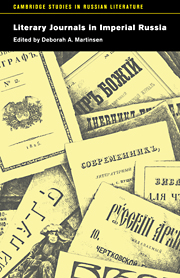Book contents
- Frontmatter
- Contents
- Notes on contributors
- Acknowledgements
- 1 Introduction
- PART I EIGHTEENTH CENTURY
- PART 2 EARLY NINETEENTH CENTURY
- PART 3 MID NINETEENTH CENTURY
- 5 Survey of Russian journals, 1840–1880
- 6 Belinsky the journalist and Russian literature
- 7 The Messenger of Europe
- 8 Dostoevsky's Diary of a Writer, journal of the 1870s
- PART 4 SILVER AGE
- List of titles of journals and almanacs
- Select bibliography
- Index
- CAMBRIDGE STUDIES IN RUSSIAN LITERATURE
8 - Dostoevsky's Diary of a Writer, journal of the 1870s
Published online by Cambridge University Press: 11 March 2010
- Frontmatter
- Contents
- Notes on contributors
- Acknowledgements
- 1 Introduction
- PART I EIGHTEENTH CENTURY
- PART 2 EARLY NINETEENTH CENTURY
- PART 3 MID NINETEENTH CENTURY
- 5 Survey of Russian journals, 1840–1880
- 6 Belinsky the journalist and Russian literature
- 7 The Messenger of Europe
- 8 Dostoevsky's Diary of a Writer, journal of the 1870s
- PART 4 SILVER AGE
- List of titles of journals and almanacs
- Select bibliography
- Index
- CAMBRIDGE STUDIES IN RUSSIAN LITERATURE
Summary
Dostoevsky's Diary of a Writer (Dnevnik pisatelia) was one of the most popular journals of the 1870s. A generically unique monojournal, the Diary drew on literary forms from feuilletons to “thick journals,” confessional novels to Utopias. Begun in 1873–74 as a column in the conservative Prince Meshchersky's weekly The Citizen (Grazhdanin), the Diary became an independent journal in 1876.
Though internationally renowned as a novelist, Dostoevsky was also one of the most successful journalists of his day. His first literary efforts in the 1840s were feuilletons. In the 1860s, following his Siberian exile, he and his brother Mikhail established two successful journals – Time (Vremia) (1863–64) and The Epoch (Epokha) (1865). In 1873–74, he edited The Citizen. Finally, in 1876–77 and again in 1880–81, he wrote, edited, and, with his wife Anna Grigorevna, published the Diary of a Writer.
In order to create interest and a pool of subscribers, Dostoevsky advertised his forthcoming journal:
In the coming year of 1876, E M. Dostoevsky's Diary of a Writer will appear monthly, in separate issues. Each issue will be composed of one to one-and-a-half printer's sheets of elite print [16–24 Pages] in the format of our weekly newspapers. It will not be a newspaper, however: all of the twelve issues will compose a whole, a book written by one pen. It will be a diary in the literal sense of the word – an account of impressions actually experienced each month, an account of what has been seen, heard, and read. Of course, it may include short or long stories, but mainly it will concern actual events.
(22: 265)- Type
- Chapter
- Information
- Literary Journals in Imperial Russia , pp. 150 - 168Publisher: Cambridge University PressPrint publication year: 1998
- 1
- Cited by



